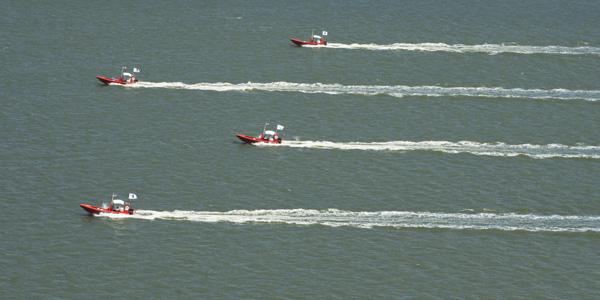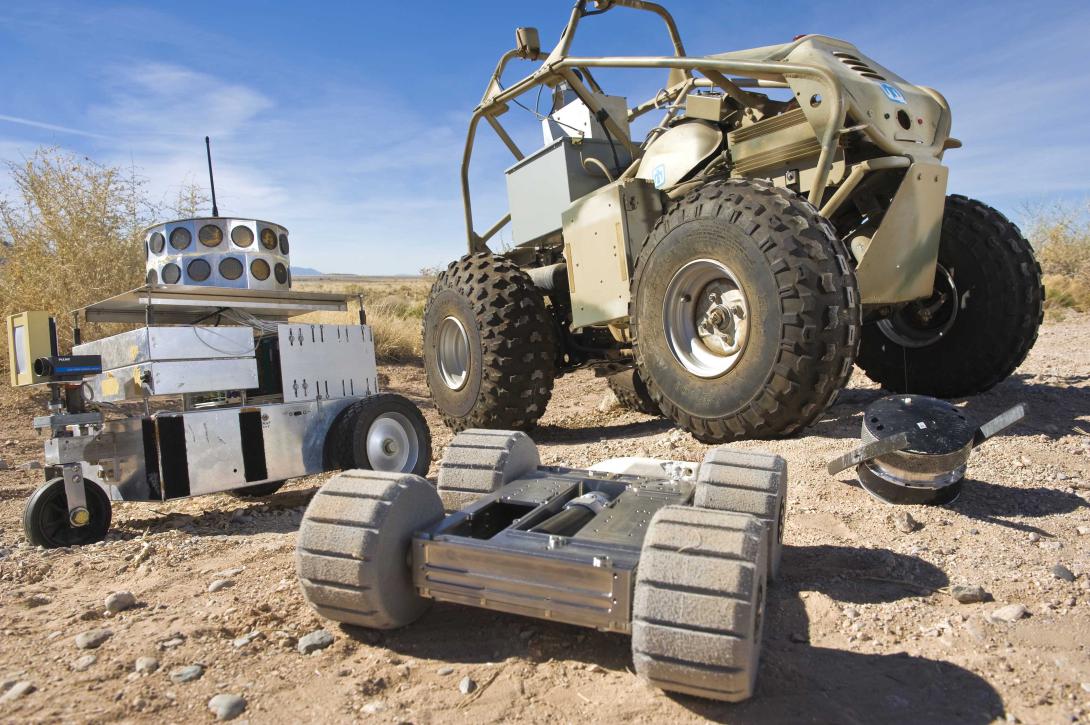Robotic Swarms Possess Paradigm-Shifting Potential
Unmanned systems deployed in ones and twos already have changed some aspects of warfighting, whether collecting intelligence, surveillance and reconnaissance data or dealing with roadside bombs. When deployed in tens, hundreds or even thousands, robotic systems may change the very nature of warfare, providing greater standoff, increased lethality and enhanced survivability while driving up the costs of war for potential enemies.
Officials at the U.S. Office of Naval Research made headlines in October when they revealed progress with the Control Architecture for Robotic Agent Command and Sensing (CARACaS) program, which is developing a sensor and software kit that can be installed on just about any vessel, making it autonomous. The service released a video demonstrating multiple boats working together to guard a Navy ship from attacks similar to those launched on the USS Cole. Additionally, swarm technology developed by the Massachusetts Institute of Technology has been used to successfully guide a fleet of 20 automated underwater robots, but future fleets could include as many as 1,000 or more such devices. Navy researchers also have developed what is essentially a flying circuit board that could be deployed by the thousands. The Air Force, meanwhile, has studied the possibility of transformer-type vehicles that could break apart into multiple flying segments and then reattach when the mission is complete.
Maj. Rod Secor, USA, deputy of the Remote Autonomous Systems Branch at the Army’s Maneuver Center of Excellence, Fort Benning, Georgia, says swarm technology looks promising. “Swarm has a lot of potential for use in the Army. We don’t think it’s ready right now, but it’s probably only a year or two before we could have some real applications for it,” Maj. Secor offers.
The current paradigm of having one operator control a single unmanned system needs to change, says Paul Scharre, a Center for a New American Security (CNAS) fellow and director of the center’s 20YY Warfare Initiative. “When you have a one-person-to-one-vehicle paradigm, there are limits to how much you can scale that up. I want to go to a one-to-many paradigm,” Scharre says.
“What you really want is a command and control paradigm where a person is not really managing or controlling any vehicle individually, but rather managing a group of them, or a swarm, and then the vehicles are cooperatively communicating among each other to divvy up tasks to accomplish some higher level purpose,” he says.”
Robotic swarms may help the military services cope with force reductions. “That’s a really significant paradigm shift because now you can put a lot more vehicles in a fight that are not necessarily tethered to personnel and to your end strength,” Scharre points out.
They might also prove to be a solution for ever-shrinking budgets. “When you have a person on board, you care quite a bit about survivability, and when you’re limited in how many you can build anyway because it’s tied to end strength, then you might as well make those vehicles as capable as you can and pile on all the features that you can. Unfortunately, that drives costs up and then that drives quantities down. And that vicious cycle has been very difficult for the department,” Scharre indicates.
With swarms of uninhabited systems, however, the platforms can be produced much more cheaply for specific missions. If one goes down, many more will carry on the mission. “You don’t have to build this thing that’s really expensive and invulnerable,” he says. “It may be cheaper to buy a lot of them, and as a whole, the swarm is resilient. This changes the paradigm of survivability.”
Scharre predicts a future in which today’s networked forces benefit from greater automation and autonomy to fight as a swarm, with greater coordination, intelligence and speed. Swarming will allow more synchronized missions, more efficient allocation of resources, self-healing networks that respond to enemy actions or widely distributed assets that cooperate for sensing, deception and attack.
He warns, however, that innovation is driven largely by the commercial sector rather than the military, which means technology will be widely available, even to potential adversaries. In fact, the country may already be involved in a robotics arms race. “Depending on your point of view, we’re there. Certainly countries like China are moving out aggressively to build unmanned aircraft of their own. They’re not as capable as some of the most cutting-edge systems the United States has today,” Scharre says. “But if you look at the Air Force budget, there is no next-generation unmanned aircraft that’s funded. That only exists on paper.”
Additionally, he points out that the Navy’s next-generation Unmanned Carrier-Launched Airborne Surveillance and Strike system (UCLASS) is embroiled in a debate about requirements. “The current version the Navy is putting forward for its UCLASS is not very capable. It’s not the best the United States could be doing in terms of building a high-end aircraft that could really be useful against a capable competitor,” Scharre opines. “I would say the United States has a lead today, but it is fragile, and it is one we could lose if we do not continue to invest in this area.”
Adversaries, however, will not necessarily have to keep up with the United States to wreak havoc. “Building a swarm of stealthy aircraft is obviously going to be hard. There will be a limited number of countries that can do that. But in terms of leveraging cheap unmanned aircraft or cars networked together for a swarm of car bombs, that stuff is not going to be far off, and we need to be ready for it,” he declares.
Scharre asserts that many are pushing for an automated, artificial intelligence-enabled response in the cyber domain, but he cautions that could be especially dangerous. He recommends taking a Cold War approach in which the United States prepares to survive a first strike in the cyber domain and then retaliate as necessary. “That second strike paradigm is one we need to think very hard about for automation and for cyberspace to see how we bake in more time for military and civilian leaders—not necessarily to slow down the pace of operations but to build in resiliency so that we can be deliberate in our response,” he explains.
Scharre recommends that the Navy build a prototype of an autonomous missile barge capable of launching missiles. The Air Force, he says, should investigate the potential for low-cost, uninhabited air vehicles to conduct a variety of missions, including suppression or destruction of enemy air defenses, reconnaissance, battle damage assessment and electronic warfare.
“Small, swarming and expendable airborne vehicles that blur the line between munitions and small unmanned aircraft have quite a bit of potential—and not just in lower-end scenarios where we have permissive airspace, but also in scenarios with very capable adversaries—to take down air defenses. That’s something we should be moving on very aggressively to learn how to use it and to be very cost prohibitive to enemies,” Scharre offers, pointing out that blurring the lines between munitions and aircraft would alter yet another paradigm.
He also supports the concept of developing applique kits for ground convoy operations and recommends that the Army and Marine Corps establish an associated program of record. Funding experimental programs, he emphasizes, is of utmost importance. “It’s not going to be obvious in many cases how to use a swarm or what to do with it, or what the command and control architecture needs to be, but we need to have a plan with all of the services that’s integrated across the department to do iterative experiments to develop the technologies to go forward—and it needs to be resourced,” Scharre indicates. “To come up with more plans and more vision documents and more road maps that are not tied to funding is pointless.”
Questioning standard procedures also is critical. “The natural inclination when we have a new technology is to use it and view it through existing paradigms. When things are really disruptive and game-changing, what’s important is figuring out what new paradigm it unlocks,” he states.
Scharre, a former Army Ranger who studied robotics issues while working in the Pentagon, authored a CNAS report released last fall titled “Robotics on the Battlefield Part II: The Coming Swarm.” It is the second in a three-report series. The first report, “Range, Persistence and Daring,” was released in May. It concludes that the winner of the robotics revolution will not be who uses it first or even who has the best technology, but instead whoever learns best how to use it. The final report, “Ethical Autonomy,” will examine whether humans should be taken out of the loop so that autonomous systems can operate more quickly and efficiently. “I don’t think, in general, that’s such a great idea,” Scharre says.







Comment
This sounds like a Michael
This sounds like a Michael Crichton novel.
Comments